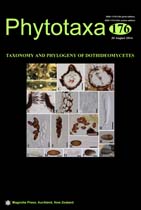Abstract
A sexual state of Setophoma, a coelomycete genus of Phaeosphaeriaceae, was found causing leaf spots of sugarcane (Saccharum officinarum). Pure cultures from single ascospores produced the asexual morph on rice straw and bamboo pieces on water agar. Multiple gene phylogenetic analysis using ITS, LSU and RPB2 showed that our strains belong to the family Phaeosphaeriaceae. The strains clustered with Setophoma sacchari with strong support (100% ML, 100% MP and 1.00 PP) and formed a well-supported clade with other Setophoma species. Therefore our strains are identified as S. sacchari. In this paper descriptions and photographs of the sexual and asexual morphs of S. sacchari are provided. The sexual state of S. sacchari is compared with Leptosphaeria sacchari, L. saccharicola, Phaeosphaeria nodorum and Sphaerulina sacchari which have similar morphological characters; however they differ in size and colour of ascospores and in the characters of the asexual state. Setophoma is clearly separated from other Phaeosphaeria species based on the phylogenetic analysis.

